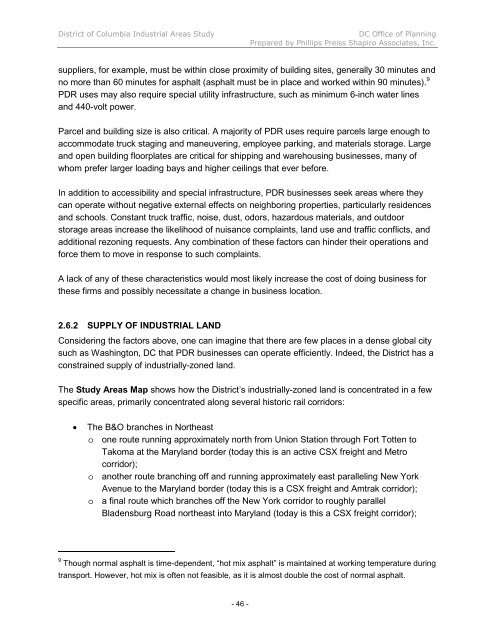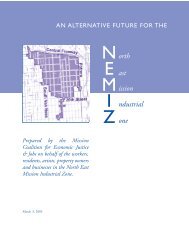INDUSTRIAL LAND IN A POST-INDUSTRIAL CITY District of ...
INDUSTRIAL LAND IN A POST-INDUSTRIAL CITY District of ...
INDUSTRIAL LAND IN A POST-INDUSTRIAL CITY District of ...
Create successful ePaper yourself
Turn your PDF publications into a flip-book with our unique Google optimized e-Paper software.
<strong>District</strong> <strong>of</strong> Columbia Industrial Areas Study DC Office <strong>of</strong> Planning<br />
Prepared by Phillips Preiss Shapiro Associates, Inc.<br />
suppliers, for example, must be within close proximity <strong>of</strong> building sites, generally 30 minutes and<br />
no more than 60 minutes for asphalt (asphalt must be in place and worked within 90 minutes). 9<br />
PDR uses may also require special utility infrastructure, such as minimum 6-inch water lines<br />
and 440-volt power.<br />
Parcel and building size is also critical. A majority <strong>of</strong> PDR uses require parcels large enough to<br />
accommodate truck staging and maneuvering, employee parking, and materials storage. Large<br />
and open building floorplates are critical for shipping and warehousing businesses, many <strong>of</strong><br />
whom prefer larger loading bays and higher ceilings that ever before.<br />
In addition to accessibility and special infrastructure, PDR businesses seek areas where they<br />
can operate without negative external effects on neighboring properties, particularly residences<br />
and schools. Constant truck traffic, noise, dust, odors, hazardous materials, and outdoor<br />
storage areas increase the likelihood <strong>of</strong> nuisance complaints, land use and traffic conflicts, and<br />
additional rezoning requests. Any combination <strong>of</strong> these factors can hinder their operations and<br />
force them to move in response to such complaints.<br />
A lack <strong>of</strong> any <strong>of</strong> these characteristics would most likely increase the cost <strong>of</strong> doing business for<br />
these firms and possibly necessitate a change in business location.<br />
2.6.2 SUPPLY OF <strong><strong>IN</strong>DUSTRIAL</strong> <strong>LAND</strong><br />
Considering the factors above, one can imagine that there are few places in a dense global city<br />
such as Washington, DC that PDR businesses can operate efficiently. Indeed, the <strong>District</strong> has a<br />
constrained supply <strong>of</strong> industrially-zoned land.<br />
The Study Areas Map shows how the <strong>District</strong>’s industrially-zoned land is concentrated in a few<br />
specific areas, primarily concentrated along several historic rail corridors:<br />
The B&O branches in Northeast<br />
o one route running approximately north from Union Station through Fort Totten to<br />
Takoma at the Maryland border (today this is an active CSX freight and Metro<br />
corridor);<br />
o another route branching <strong>of</strong>f and running approximately east paralleling New York<br />
Avenue to the Maryland border (today this is a CSX freight and Amtrak corridor);<br />
o a final route which branches <strong>of</strong>f the New York corridor to roughly parallel<br />
Bladensburg Road northeast into Maryland (today is this a CSX freight corridor);<br />
9 Though normal asphalt is time-dependent, “hot mix asphalt” is maintained at working temperature during<br />
transport. However, hot mix is <strong>of</strong>ten not feasible, as it is almost double the cost <strong>of</strong> normal asphalt.<br />
- 46 -












